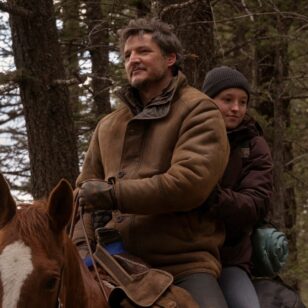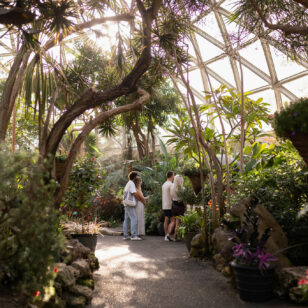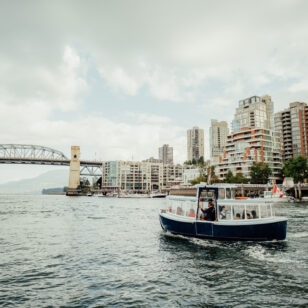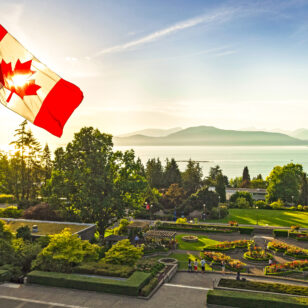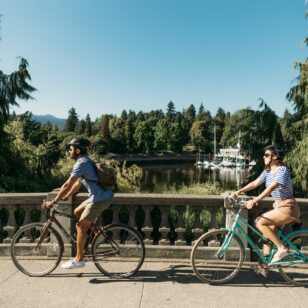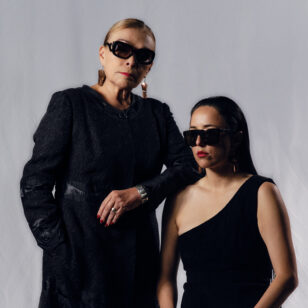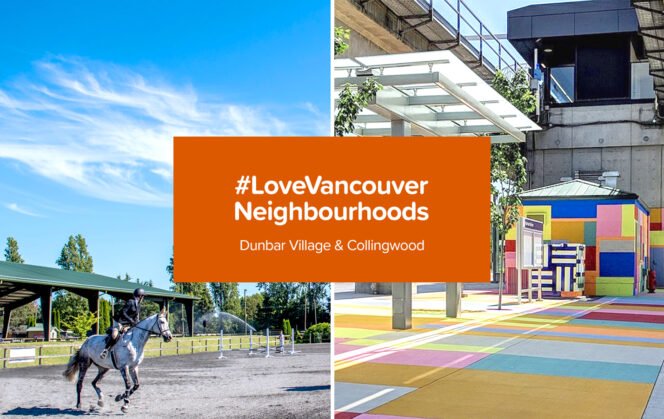
Our #LoveVancouver Neighbourhood series rolls on with two areas that have held onto their little-city-within-a-city charm, despite all the changes a rapidly growing metropolis like Vancouver can bring. From the rural, time-stood-still feel of Dunbar Village, to the multicultural flavour bomb of Collingwood, here’s two more neighbourhoods well worth exploring.
Dunbar Village
Long before the first non-native settlers arrived to the land now known as Dunbar, it was home to the Musqueam First Nation. Situated at the mouth of the Fraser River, the area provided ample hunting and fishing for the Coast Salish peoples that settled here, as well as sustenance a little less terrestrial. The Camosun Blog, or məqʷe:m, on the edge of Dunbar in Pacific Spirit Park has long been revered as a portal to the spirit world, and remains a rich source of story and tradition.
Dunbar, then known as Southlands, became a part of the newly incorporated District of South Vancouver in 1892. But it remained mostly a mess of logged forest full of fallen and burnt timber until 1912 when the Mount family built the first settler’s shack, and the Dunbar we know today began to develop. A year later streetcars clacked into the area and by 1927, Dunbar was connected by three streetcar routes to the city of Vancouver, which it would become part of in 1929.
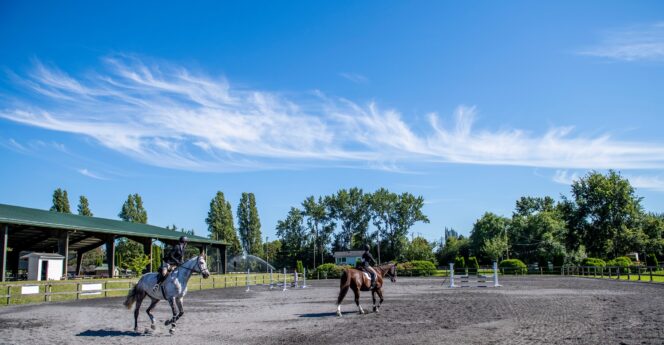
Photo credit: Cara Grimshaw Photography
Dunbar still retains its initial countryside charm thanks to the preservation of much of the architecture from its early settlement days along broad residential streets lined with grand trees. The Southlands district within Dunbar is sometimes said to be home to more horses than people, with its rural farmland, stables and renowned equestrian club, the Southlands Riding Club that has been imparting the responsibility and discipline of equine life to the area’s children since 1943.
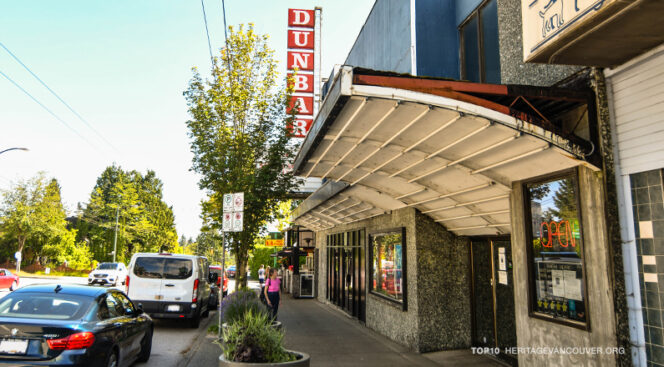
Photo credit: Heritage Vancouver
But perhaps the most iconic building in all of Dunbar is the one that boasts its name in towering red blocks along Dunbar Street. The Dunbar Theatre has been in operation since 1935, once run by J. Howard Boothe, a pioneer of BC’s film industry and Hollywood insider. Built in an eye-catching Art Deco Style, the Dunbar is easily one of Vancouver’s most beloved historic venues. Not one to rest on its laurels however, the Dunbar has remained in business even through the pandemic by offering popcorn, candy and other made-for-the-movies treats to residents as they enjoy their films at home.
It’s a good metaphor for Dunbar itself, a neighbourhood open to change — on its own terms.
Hidden gems we love in Dunbar:
Stong’s Market – Hardly “hidden” to the lucky folks that live nearby, this revered grocery store has been feeding families since 1955, growing in size with each new location along Dunbar Street to where it sits today across from the Dunbar Theatre.
The Cheese Inn – This one’s for the Anglophiles, who need it right now. Step into a classic English pub with its authentic Tudor style framing and all the Cottage Pie, Toad in the Hole or Bangers and Mash you need to comfort you after a tough blow at the Euros.
HOB Too Thrift Shop – Find all kinds of gems hidden in one of Vancouver’s best shops for high-quality vintage and nearly new household collectibles, memorabilia, and furniture. Best part is you’ll be supporting the Vancouver Hospice Society and all the great work they do.
How to get there:
To get to Dunbar take the #7 bus from Nanaimo Station, or if you’re coming from the east, hop on the #25 UBC from Brentwood.
Learn more about Dunbar Village by visiting www.dunbarvillage.ca.
Collingwood
On the opposite end of the city along the easterm border before Burnanby sits one of the largest and oldest neighbourhoods in Vancouver. Collingwood began its modern life in 1861 when Colonel Richard Moody made his attempt at cutting through the thick forest here along an ancient Musqueam First Nation trail from the far banks of the Fraser River to English Bay. He claimed about one square kilometer of land in the middle where Collingwood now exists, attracting mostly farmers including the Avalon Dairy that is still going strong today.
Since then, Collingwood has been a hub of transportation for the city. Vancouver’s first street cars appeared here in 1890 when fare was a nickel to ride from downtown to New Westminster. Around the same time, Kingsway was becoming a major thoroughfare as it cut through the southern half of the neighbourhood. All this traffic opened up the area even further and by 1913, a small town was quickly growing along Joyce Street anchored by Vancouver’s first one-room schoolhouse. The first business was the Collingwood Inn, built of course to cater to the stagecoaches travelling through.
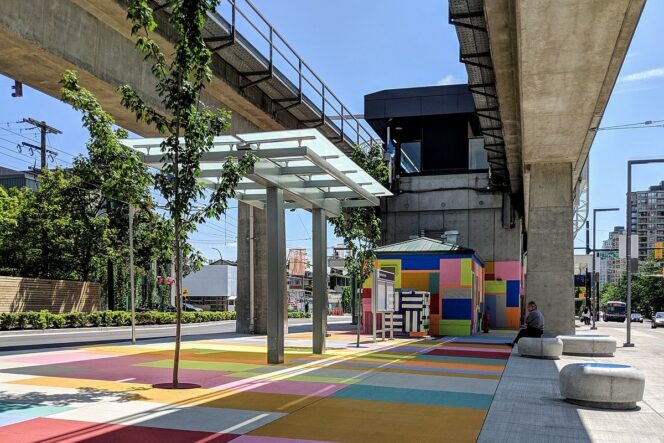
Today, Collingwood carries on the tradition of movement, seeing roughly 40,000 commuters run through the area every day along Kingsway, Grandview Highway and Boundary Road. Joyce-Collingwood Station brings the Skytrain through along the original Central Park Line of the historic British Columbia Electric Railway. Being so connected, it’s no wonder Collingwood has become home to over 50,000 residents, many abiding in rows of iconic Vancouver Specials. A mere 28% of these households state English as their first language, making Collingwood one of Vancouver’s most diverse neighbourhoods as well.
One can see this multicultural medley well on display in the many small businesses that have sprung up along streets adorned with colorful lamppost banners and scented by the open doors of bakeries, delis, and restaurants offering up cuisine from around the world. From the exciting flavours of Hakka Chinese Indian at Chilipepper House, to the sweets at Panaderia Latina Bakery, there’s plenty to explore for the adventurous foodie.
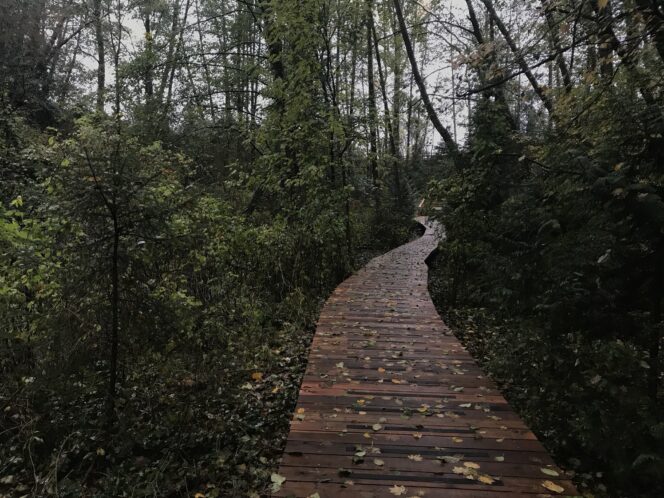
Photo credit: @CBCMargaretG
As busy as this neighbourhood is on any given day, one can still get a true sense of the vast wilderness that once ruled here with a walk through Renfrew Ravine Park along Still Creek taking its own steady commute down rolling hills.
HIdden gems we love in Collingwood:
2400 Motel – If you’ve ever seen a movie made in Vancouver, you’ve probably seen a shot of this iconic roadside motor court motel on Kingsway. It’s camera-ready nostalgia owes to the fact its facade has not changed much since it opened in the 40s.
Max’s Restaurant – What began just after World War II, when Maximo Gimenez first served American troops his niece’s special recipe fried chicken, now offers up traditional Filipino cuisine in the heart of Vancouver.
Li’s China Grill – One of a handful of authentic regional Chinese restaurants along KIngsway, Li’s serves up Chongqing grilled fish from the Wanzhou district of the same name in Sichuan. This delicacy is designed for sharing, so bring some friends and dig into a whole fish grilled with your choice of chili topping. Wash it all down with a cold Tsingtao.
How to get there:
To get to Collingwood, take the Expo or Millenium Line to Joyce-Collingwood station to be dropped right in the middle of the action. Otherwise the #19 bus will run you along Kingsway, or the #41 will bring you east from UBC.
Learn more about Collingwood by visiting www.shopcollingwood.ca.
Visit www.tourismvancouver.com/love for vacation inspiration and special offers on hotels and attractions.
#LoveVancouver
#explorecanada











